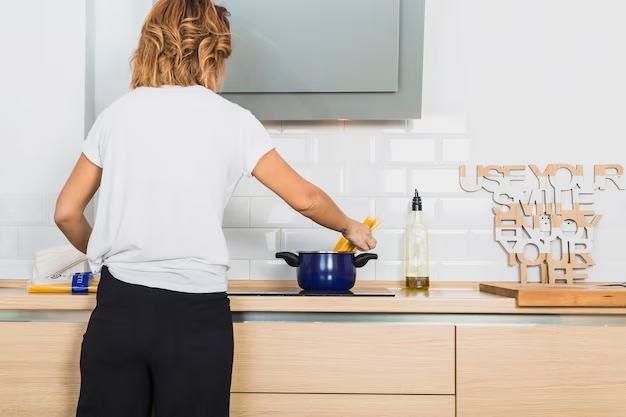Is It Safe to Place a Stove Next to a Refrigerator? A Comprehensive Guide
When setting up a kitchen, one question frequently arises: Can you put a stove next to a refrigerator? Many people face this dilemma due to space constraints, especially in small kitchens or apartment layouts. While the aesthetics of kitchen design might influence this decision, the practicality and safety aspects are paramount. In this article, we will explore this topic from different angles to provide a clear, comprehensive understanding that empowers you to make an informed decision.
The Core Issue: Heat vs. Cold
Understanding Kitchen Appliances
Before diving into the specifics of positioning, it's essential to grasp the basic operation of these kitchen cornerstones:
- Stoves generate heat to cook food. Whether you're using gas or electric, the appliance emits heat not only directly but also radiates ambient warmth, especially during extended use.
- Refrigerators work to keep things cold, maintaining temperatures well below room temperature. They pull heat away from stored food, a process requiring isolation from external heat sources to function efficiently.
Impact of Proximity
Placing a stove next to a refrigerator can cause a couple of significant issues:
Efficiency Loss: Refrigerators work harder and consume more energy in a warmer environment. The heat from the stove can force the fridge to run more frequently, trying to maintain its internal cool temperature.
Wear and Tear: Constant exposure to heat can affect a refrigerator's lifespan, potentially leading to increased maintenance or early replacement.
Safety First: Considerations for Close Placement
Fire Safety Concerns
Safety should always be the top priority. The proximity of heat sources, like a stove, to other appliances raises the following safety concerns:
Heat Damage: Over time, nearby cabinetry or other structures could scorch or suffer heat-related damage.
Fire Hazard: Flammable items stored next to a stove can pose a serious risk, especially in compact kitchens.
Managing Safety With Smart Design Choices
For those with limited space, here are creative design solutions to balance the necessary proximity without compromising safety:
Heat Shields or Reflectors: Install heat-resistant barriers between the stove and refrigerator to minimize heat transfer. These can be both functional and stylish.
Proper Ventilation: Ensure good airflow with an overhead vent or range hood to help dissipate heat effectively.
Wall Insulation: Consider adding an insulated wall between these appliances. This can be achieved with fire-retardant materials and acts as both a barrier and a safety measure.
Alternatives and Kitchen Layout Solutions
Standard Kitchen Layouts
Understanding common kitchen layouts can help in planning an optimized space:
Galley Kitchen: Often found in apartments, a galley kitchen features two parallel counters. Stoves and refrigerators can be placed on opposite sides to maximize space utility while mitigating heat issues.
L-Shape and U-Shape Kitchens: These configurations often allow for more appliance separation, typically seen in homes with more expansive kitchen spaces.
Creative Space-Saving Solutions
When layout options are limited, consider these alternatives:
Compact Appliances: Utilize smaller or combined appliances to conserve valuable space, allowing more strategic positioning.
Buddy System: Group appliances with similar environmental needs (e.g., ovens and stovetops) away from those requiring isolation, like refrigerators.
Additional Insulation: Install additional insulation within the cabinetry near heat-producing or heat-sensitive appliances.
Efficiency and Cost Implications
Energy Efficiency Concerns
Energy efficiency might decline with improper placement, impacting both appliances' performance. Key takeaways include:
Inadequate Cooling: When frequently exposed to higher ambient temperatures, refrigerators lag with optimal cooling performance.
Increased Energy Bills: Hard-working appliances mean energy would be consumed unnecessarily, leading to inflated utility costs.
Cost Considerations
Initial costs to consider might include the price of any additional modifications, such as heat shields or installing better ventilation systems. However, the long-term cost savings from reduced energy bills and potentially extending the lifespan of your appliances could outweigh the initial expenditure.
Skimmable Summary: Key Takeaways
🌟 Placement Concerns:
- Avoid close stove-refrigerator proximities to prevent energy inefficiency and wear.
🔥 Safety Measures:
- Install heat shields or reflectors.
- Ensure proper ventilation.
- Use insulated barriers effectively.
📏 Optimal Layouts:
- Consider galley, L-shaped, or U-shaped layouts for separation.
- Opt for compact appliances in tight spaces.
💰 Cost Implications:
- Improper appliance placement may lead to higher energy costs.
- Initial investments in safety modifications can offer long-term savings.
Balancing aesthetics, practicality, and safety in kitchen design isn't simple, but armed with the right knowledge, you can create a functional and visually appealing kitchen. Whether working with a large remodel or making the most out of a compact space, understanding the impact of your kitchen layout choices ensures you aren’t caught off guard by higher energy bills or unnecessary maintenance issues. By considering these factors, you'll improve your kitchen's efficiency and longevity.
